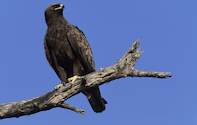
With emphasis on the huge potential for 'birding' tourism in our region, some previously quoted statistics are repeated without apology. The north-eastern lowveld and escarpment area has diverse habitats with considerable altitudinal variation.
The region between Nelspruit and Tzaneen contains dry savanna, mixed bushveld, granite outcrops, rivers and seasonal water courses fringed with larger trees, scattered dams and water points, wooded mountain slopes, high cliffs, gorges, patches of 'rain forest' and highveld grasslands.
The escarpment extending down the length of the area attracts high and low altitude species and is an important migratory route for summer visitors. The majority of species are resident breeders, some of which have an east-west, altitudinal movement for seasonal climatic and foraging purposes.
During extreme weather conditions in the Mozambique channel some unusual species are driven inland from the eastern coastal areas and highveld species are driven to lower altitudes by violent storms. New sightings are constantly being recorded.
Greatest Diversity
The north-eastern region has, arguably, the highest birdcount of any area in South Africa. Confirmed records from many localities within the region (with several submissions still to be included) combine to produce an impressive total.
With several species still to be confirmed, there are in excess of 600 species for the area. Due to an increase in interest and awareness, new and surprising records are constantly being reported. A preliminary bird list, currently being up-dated, is available to those interested in assisting the regional count.
Birds Of Prey (Raptors)
Birds of prey, with prominence of size and affinity to wilderness, probably provide the greatest attraction to many 'birders'. Diurnal raptors include the Secretary Bird, all vultures, sparrow hawks, goshawks, buzzards, kites, harriers, osprey, eagles, hawkeagles, snake eagles, falcons, hobbys and kestrels. owls comprise the nocturnal raptors.
Of the 70 diurnal raptor species recorded in South Africa, 62 (88%) have been confirmed within our region. All the 12 species of owls have been recorded. These impressive statistics have important potential as an attraction for 'birders' visiting the area. To help protect this 'tourism asset', part of the Kruger to Canyon is in the process of being declared a 'Raptor Reserve' which will be prominently demarcated and advertised.
Many of the species are slow breeding and vulnerable to disturbance and ill-planned 'development'. Certain species are vulnerable to poisoning by irresponsible use of pesticides, careless driving and misplaced belief in 'traditional' treatments and superstitions. Each species has a vital role to play in the control of potential 'agricultural pests' and maintenance of a healthy and stimulating environment.Rare And Vulnerable Species
Most of our larger birds are particularly susceptible to habitat destruction. Many are facing extinction due to lack of suitable and undisturbed nesting sites and feeding areas. Secretary Birds, Tawny Eagles, Bateleurs, Ground Hornbills, Bald Ibis, Storks and others are in this vulnerable category.
Several species that are marginal within their known distribution are considered rare or vagrant in the region. blue swallows, mottled swifts, eastern saw-wing, palm-nut vulture, Egyptian vulture, lammergier, ayres eagle, leonora's falcon, sooty falcon and others could be included in this category.
The degradation of our water-ways and pressure on existing water supplies is threatening many species reliant on aquatic conditions. pel's owl, African finfoot, black riverduck, and some smaller herons are examples. Taita Falcons are a unique and valuable 'draw' to birding visitors. Of uncertain status they must be considered scarce and worthy of special protection.Reference Guides And Need For Expanded Observation
Reference books at our disposal contain the known information on birds and are a valuable asset to distribution, identification and habits of species. With changes in weather patterns and habitat much of the recorded detail will also change. Distribution maps constantly change and should not be used to confine the search for new distributions and even additional species.
Great surprise is expressed at the sighting of a bearded vulture (lammergier) in the Kruger Park, having flown only about 400 kilometres from known territory, but we happily accept the annual appearance of willow warblers and barn swallows after a flight of over 6000 kilometres.
Don't become 'blinkered' by present information. Be constantly on the lookout for unexpected species and make detailed record of any observations to verify new information.
The 'experts' don't pretend to know it all and rely on the honest and substantiated bservations of all interested birders. Make contact with BirdLife or some credible bird club and send in your records. You may well contribute valuable new information to the present fund of knowledge.

 Learn more about African birds. An information guide on birds in Kruger National Park. This Birds of Africa guide offers bird watching enthu...
Learn more about African birds. An information guide on birds in Kruger National Park. This Birds of Africa guide offers bird watching enthu...